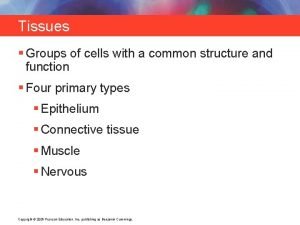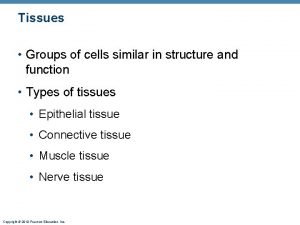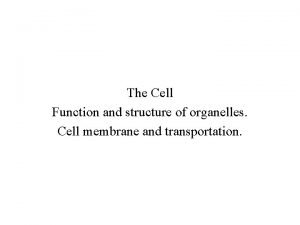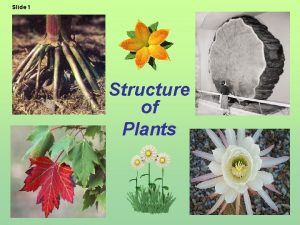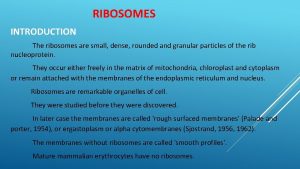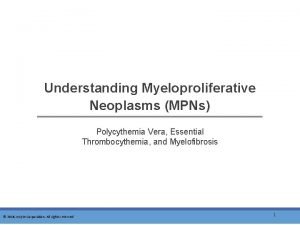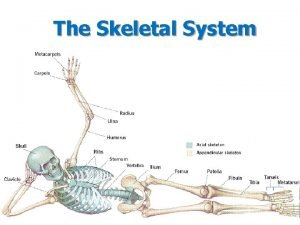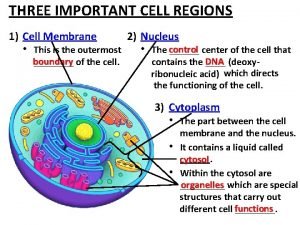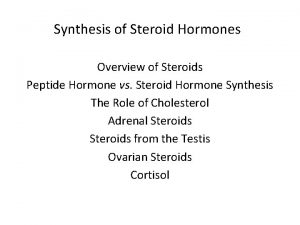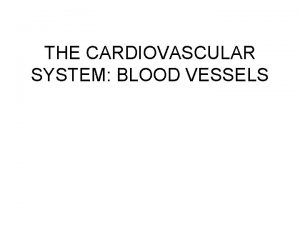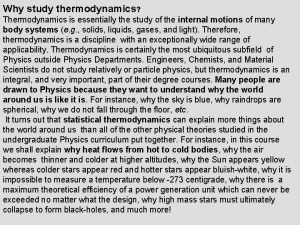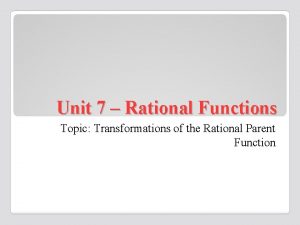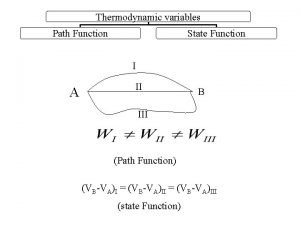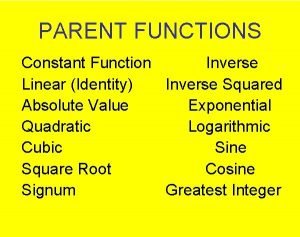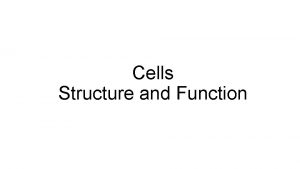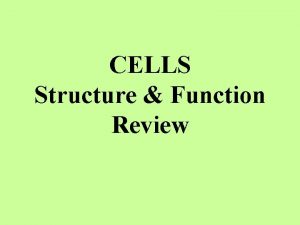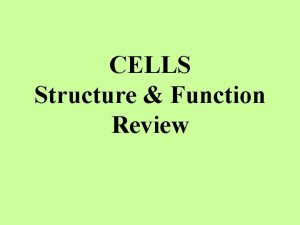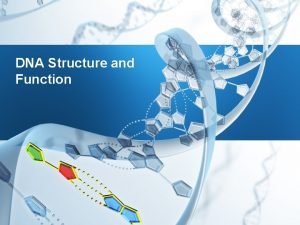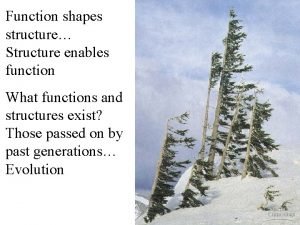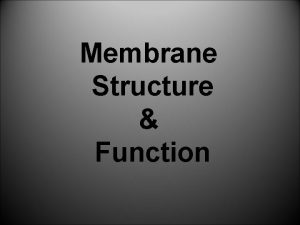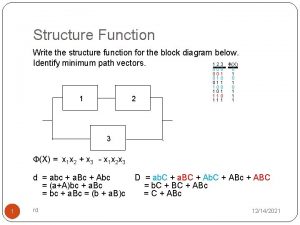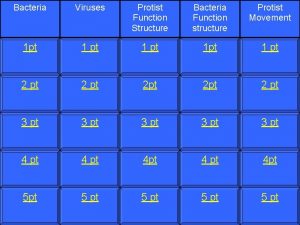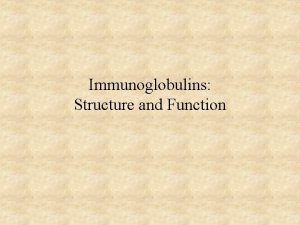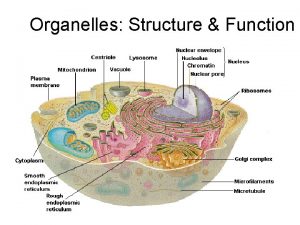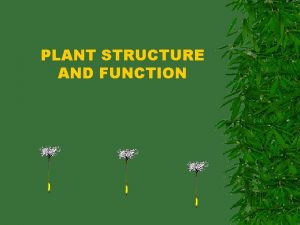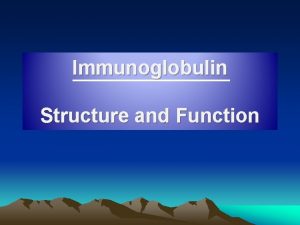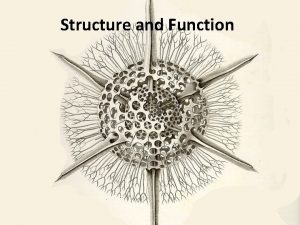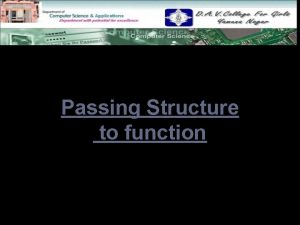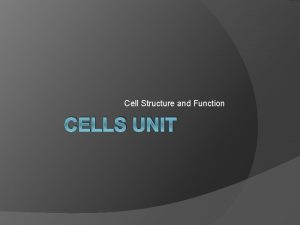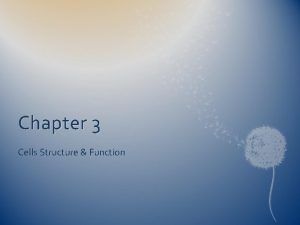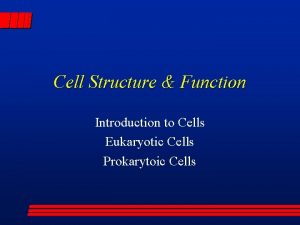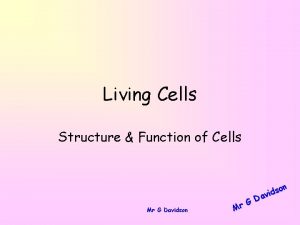Cells Structure function 1 What are cells 2




































- Slides: 36

Cells: Structure & function

1. What are cells? 2. Cells are the basic unit of ALL living things 3. “cell” was coined by Robert Hooke viewing cork cells

1. What are cells? 2. Cells come in many sizes (mm – nm)

1. What are cells? 2. All cells share these traits 3. a cell membrane 3. Cytoplasm 3. DNA (genetic material)

1. What are cells? 2. Cells are classified 3. Prokaryotic cells have NO nucleus 3. Eukaryotic cells HAVE a nucleus

1. How do cell structures help the cell? 2. Cytoplasm 3. Thick fluid contains nutrients & organelles 3. Contains cytoskeleton

1. How do cell structures help the cell? 2. Cytoskeleton 3. Contains filaments & fibers 4. Supports cell shape 4. Helps to move materials

1. How do cell structures help the cell? 2. Nucleus 3. Control center of cell 3. Contains 4. Chromosomes (chromatin) 4. Nucleolus

1. How do cell structures help the cell? 2. Nucleolus • 3. Forms ribosomes

1. How do cell structures help the cell? 2. Ribosomes 3. Make proteins

1. How do cell structures help the cell? 2. Cell membrane 3. Controls what goes in & out of cell

1. How do cell structures help the cell? 2. Rough Endoplasmic Reticulum 3. RER transports (like a highway) 3. Ribosomes attached to surface

1. How do cell structures help the cell? 2. Smooth Endoplasmic Reticulum 3. No attached ribosomes 3. Has enzymes that help build lipid molecules

1. How do cell structures help the cell? 2. Golgi body • 3. Packaging & shipping station of cell

1. How do cell structures help the cell? 2. Mitochondria 3. Have their own DNA 3. Bound by double membrane

3. Break down fuel molecules (cellular respiration) – Glucose – Fatty acids 3. Release energy – ATP

1. How do cell structures help the cell? 2. Lysosomes • 3. Contain enzymes • 3. Functions – Break down old cell parts

1. How do cell structures help the cell? 2. Centrioles • 3. Pairs of microtubular structures • 3. Play a role in cell division • 3. Animal cells

1. How do cell structures help the cell? • 2. Cell Walls 3. Found in plants, fungi, & many protists 3. Supports & protects cell

1. How do cell structures help the cell? 2. Chloroplasts 3. Carries out photosynthesis 3. Makes cellular food – glucose

1. How do cell structures help the cell? 2. Vacuoles • 3. Membrane bound storage sacs • 3. More common in plants than animals • 4. Contents – Water – Food – wastes

1. What is the job of the cell membrane and how is it organized? 2. Function: Regulates what goes in and out of cells

1. What is the job of the cell membrane and how is it organized? 2. 2 main parts: 3. Phospholipid bilayer 3. Proteins

1. What is the job of the cell membrane and how is it organized? 2. Phospholipid bilayer: 2 layers 3. Outside=hydrophilic : likes water 3. Inside=hydrophobic : hates water

1. What is the job of the cell membrane and how is it organized? 2. Proteins 3. transporters, receptors, enzymes & anchors

1. What is the job of the cell membrane and how is it organized? 2. Proteins 3. transporters, receptors, enzymes & anchors

1. What is the job of the cell membrane and how is it organized? 2. Fluid Mosaic Model describes how: 3. membrane molecules move 3. there are many types of molecules

1. Why do cow barns smell worse on warm days? 2. Diffusion: Movement of particles from greater to lesser concentration

1. Why do cow barns smell worse on warm days? 2. Molecules eventually reach equilbrium

1. Why do cow barns smell worse on warm days? 2. Several factors impact the speed of diffusion 3. heat 3. motion 3. concentration

1. Why do cow barns smell worse on warm days? 2. Gases diffuse in and out of cells 3. O 2, CO 2 because they are SMALL

1. Why do cow barns smell worse on warm days? 2. Large molecules move through protein channels 3. Facilitated diffusion: no ATP energy/with concentration gradient 3. active transport: uses ATP energy/ against concentration gradient

1. How do cells respond to changing water conditions? 2. Water moves in and out of a cell by osmosis (water diffusion) SALT SUCKS!!!!!

1. How do cells respond to changing water conditions? 2. Cells can… 3. take in water 3. maintain water 3. lose water

1. How do cells respond to changing water conditions? 2. Osmosis depends on the concentrations of solutes (salts) 3. Hypotonic= less salts/more water 3. Isotonic= equal salts 3. Hypertonic= more salts/less water

1. How do cells respond to changing water conditions? 2. Examples of osmosis 3. wilting celery – lost water; crisp celery up- gain water 3. swollen ankle will lose water to Epsom salt bath
 Mikael ferm
Mikael ferm Muscle tissue parts
Muscle tissue parts A group of cells similar in structure and function
A group of cells similar in structure and function A group of cells similar in structure and function
A group of cells similar in structure and function Paranasal sinus development
Paranasal sinus development Regulation of tubular reabsorption
Regulation of tubular reabsorption Pineal gland
Pineal gland How are somatic cells different from gametes
How are somatic cells different from gametes Somatic cells vs germ cells
Somatic cells vs germ cells Chlorocruorin
Chlorocruorin Eukaryotic vs prokaryotic
Eukaryotic vs prokaryotic Plant animal cell venn diagram
Plant animal cell venn diagram Prokaryotic cell
Prokaryotic cell Organelle trail
Organelle trail Masses of cells form and steal nutrients from healthy cells
Masses of cells form and steal nutrients from healthy cells Label
Label Prokaryotic cells vs eukaryotic cells
Prokaryotic cells vs eukaryotic cells Prokaryotic cell wall
Prokaryotic cell wall Nondisjunction in meiosis
Nondisjunction in meiosis Cells and life lesson 1 answer key
Cells and life lesson 1 answer key How cells function
How cells function Functions of leaf
Functions of leaf Function of ribosomes
Function of ribosomes Function of cells
Function of cells Complications of myelofibrosis
Complications of myelofibrosis White blood cells function
White blood cells function Regions of the cell
Regions of the cell Steroid function
Steroid function What is function of goblet cells
What is function of goblet cells Circulatory pathway
Circulatory pathway A saclike structure in which cells store materials
A saclike structure in which cells store materials Why do we study thermodynamics
Why do we study thermodynamics Rational functions parent function
Rational functions parent function Transformations of rational functions
Transformations of rational functions Pressure is state function or path function
Pressure is state function or path function Domain of log function
Domain of log function Linear or not
Linear or not

